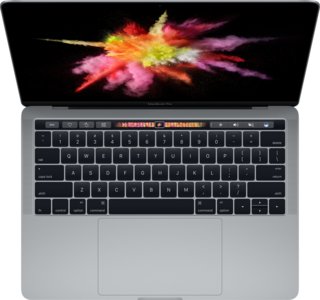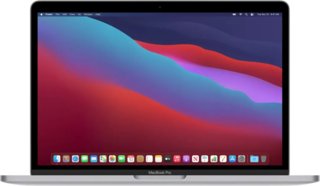Apple MacBook Pro (2017) 13" with Touch Bar and Touch ID / Intel Core i5 256GB vs Apple MacBook Pro (2020) 13.3" Apple M1
Let's compare Apple's MacBook Pro Models: the 2017 version with a Touch Bar and Touch ID, and the 2020 model powered by the superior Apple M1 chip. Both laptops have attractive designs, strong performances, and intuitive features for an improved computing experience. However, your choice may depend on specific prominent differences between these two versions.
The 2017 MacBook Pro runs on an Intel processor, providing good performance for daily tasks. However, it may lag with heavy workloads. Noteworthy features include the Touch Bar for easy navigation and Touch ID for added security.
The 2020 MacBook Pro takes things up a notch with its custom Apple M1 chip, delivering speedier performance and improved energy efficiency. It's a standout choice for creative tasks, boasting enhanced graphics that make visuals pop.
Both laptops come with beautiful high-resolution Retina displays and durable aluminum bodies that look great and can withstand daily use. However, the 2020 model stands out by being faster and having a longer battery life thanks to its M1 chip, offering a significant upgrade over the 2017 version.
Choosing between these two models depends on what you need from your laptop. For everyday tasks and moderate creative projects, the 2017 model is a solid pick. It's reliable and gets the job done. On the other hand, if you handle more intensive tasks or you're a professional needing high performance, the 2020 model is worth considering. It offers enhanced capabilities to meet demanding requirements.
System and application performance
Performance in popular 3D games
Viewing angle, color accuracy...
Ports, webcam and other interfaces
Potential battery life
Materials, durability and portability
Design Comparison
Size Comparison
Comparing the design elements of the Apple MacBook Pro (2017) 13" with Touch Bar and Touch ID to the Apple MacBook Pro (2020) 13.3" Apple M1 reveals crucial factors that impact user experience, such as ergonomics, materials, build quality, portability, and distinctive design features.
Ergonomics:- Both models have the same dimensions of 12 inches in width, 8.4 inches in height, and 0.6 inches in thickness, making them compact and convenient for portable use.- Both laptops feature a backlit keyboard that improves usability in low-light conditions, boosting productivity for students and professionals in different settings.- Equipping both models with a fingerprint scanner provides users with convenient security features while ensuring easy access.
Materials & Build Quality:- Both laptops feature premium aluminum construction, offering a sleek and durable design that reflects sophistication and guarantees lasting reliability.- The consistency in materials showcases Apple's dedication to superior craftsmanship, attracting users who appreciate a luxurious touch in their devices.
Portability:- Both laptops are lightweight and portable, making them convenient for moving between classes or meetings despite a slight weight variation (3 pounds for the 2017 model compared to 3.1 pounds for the 2020 model).- These laptops have a sleek design that boosts portability without sacrificing performance or features.
Unique Design Features:- The 2020 model now supports Wi-Fi 6, providing faster wireless connectivity than the previous versions. This enhancement benefits users who value smooth internet access for online activities.
- An additional microphone on the 2020 model enhances audio input capabilities, potentially benefiting professionals engaging in conference calls or students recording lectures.
Practical Usability & Aesthetic Appeal:- Both laptops offer a blend of compact dimensions and lightweight design, providing users with portability and performance.The sleek aluminum chassis complements Apple's minimalist design approach, attracting those who appreciate modern aesthetics in their tech gadgets.Design choices like backlit keyboards and fingerprint scanners improve usability by offering practical features that simplify daily tasks and contribute to an elegant aesthetic.
In summary, both the Apple MacBook Pro (2017) with Touch Bar and Touch ID and the Apple MacBook Pro (2020) with M1 chip present attractive design features that meet user demands in various situations. The 2020 model enhances wireless connectivity and audio input, while maintaining consistent user experience with the familiar ergonomics, build quality, and portability shared by both devices.
Screen Comparison
| Apple MacBook Pro (2017) 13" with Touch Bar and Touch ID Intel Core i5 256GB | Apple MacBook Pro (2020) 13.3" Apple M1 | |
|---|---|---|
| Resolution | QHD | QHD |
| Screen Size | 13.3" | 13.3" |
# Laptop Screen Comparison: Apple MacBook Pro (2017) 13" vs. Apple MacBook Pro (2020) 13.3
Comparing the screen aspects of the Apple MacBook Pro 13-inch models from 2017 and 2020 shows significant differences in screen resolution, size, and display technology that affect user experience in activities such as gaming or professional graphic design.
Screen Size:
- Apple MacBook Pro (2017): Comes with a 13.3-inch display.
- Apple MacBook Pro (2020): Features a 13.3-inch screen size.
User Impact: The identical screen sizes in both models ensure consistency for users transitioning between the two laptops. It provides a familiar workspace, particularly for tasks requiring precise visual details like graphic design.
Screen Resolution:
- Both Laptops: Feature a resolution of 2560 x 1440 pixels.
- Pixel Density: Achieves a resolution of 227 pixels per inch (ppi).
User Impact: The similar resolution and pixel density guarantee sharp image quality and clarity on both laptops. This is beneficial for tasks that demand accurate color representation such as photo editing or video production.
Display Technology:
- Both Laptops: Utilize IPS, LCD, LED-backlit display technology.
- Added Feature: The Apple MacBook Pro (2020) now offers a brighter display with 500 nits of brightness.
User Impact: The increased brightness of the 2020 model improves visibility in bright settings, enhancing its suitability for outdoor use or well-lit areas. This is particularly beneficial for professionals who depend on precise color accuracy across different lighting conditions.
Supported Displays:
- Apple MacBook Pro (2020): Supports up to 2 external displays.
User Impact: The ability to connect to multiple external displays with the 2020 model enables increased productivity by expanding screen real estate. This feature is valuable for multitasking scenarios or professionals working across multiple applications simultaneously.
In conclusion, although both Apple MacBook Pro models have similar screen resolutions and sizes with high pixel density, the Apple MacBook Pro (2020) distinguishes itself with its higher brightness levels and ability to connect to two external displays simultaneously.
Hardware Comparison
| Apple MacBook Pro (2017) 13" with Touch Bar and Touch ID Intel Core i5 256GB | Apple MacBook Pro (2020) 13.3" Apple M1 | |
|---|---|---|
| CPU | Intel Core i5 | Apple M1 |
| RAM | 8GB | 8GB |
| Storage Size | 256GB | 512GB |
Comparing the hardware specifications of the Apple MacBook Pro (2017) 13" with Touch Bar and Touch ID, equipped with an Intel Core i5 processor, 8GB RAM, and 256GB storage, to the Apple MacBook Pro (2020) 13.3" with Apple M1 chip, 8GB RAM, and 512GB SSD brings crucial factors to light. Let's explore these details to assist you in making a well-informed choice.
CPU:
- 2017 MacBook Pro: Intel Core i5 running at 3.1GHz
- 2020 MacBook Pro: Apple M1 chip
Performance Impact: The Apple M1 chip in the 2020 model outshines the Intel Core i5 in terms of efficiency and performance for multimedia tasks and heavy software operations due to its advanced architecture specifically designed for Mac systems.
RAM:
- Both Models: Equipped with 8GB RAM
Performance Comparison: Although both laptops feature identical RAM capacities, the newer model boasts faster RAM speed at 4266MHz, outperforming the 2133MHz speed of its predecessor. As a result, the 2020 MacBook Pro offers enhanced multitasking capabilities for a smoother user experience.
Storage:
- 2017 MacBook Pro: Internal storage of 256GB
- 2020 MacBook Pro: Larger internal storage of 512GB SSD
Performance Impact: The increased storage capacity in the 2020 model allows for more space to store multimedia files, software, and documents without compromising speed or performance.
GPU (Graphics Processing Unit):
- 2017 MacBook Pro: Integrated GPU
- 2020 MacBook Pro: Integrated GPU within Apple M1 chip
Performance Impact: Both laptops feature integrated GPUs suitable for everyday tasks. However, users engaging in graphics-intensive activities may notice a boost in performance on the Apple M1 chip due to its efficient graphics processing capabilities.
For those focused on performance efficiency and improved multitasking, the Apple MacBook Pro (2020) with Apple M1 chip, faster RAM speed, and larger SSD storage is a reliable option. Alternatively, those with budget constraints may find the Apple MacBook Pro (2017) suitable for basic tasks but less capable with demanding applications.
Battery Comparison
| Apple MacBook Pro (2017) 13" with Touch Bar and Touch ID Intel Core i5 256GB | Apple MacBook Pro (2020) 13.3" Apple M1 | |
|---|---|---|
| Battery Life | 10 hours | 17 hours |
Comparing the battery life of the Apple MacBook Pro (2017) 13" with Touch Bar and Touch ID that has an Intel Core i5 processor and 256GB storage to the 2020 Apple MacBook Pro 13.3" powered by the Apple M1 chip with 8GB RAM and a 512GB SSD, reveals significant differences.
Apple MacBook Pro (2017) 13" with Touch Bar and Touch ID / Intel Core i5 / 8GB RAM / 256GB SSD:- Battery Life: Users can enjoy up to 10 hours of battery life with this model, providing extended usage without the need for frequent recharges.
Apple MacBook Pro (2020) 13.3" with Apple M1 Chip, 8GB RAM, and 512GB SSD:- Battery Life: The newer model boasts a remarkable improvement in battery life, offering up to 17 hours of usage compared to its predecessor, significantly extending the time between charges.
- Added Functionality: The MacBook Pro (2020) is equipped with Sleep And Charge USB ports, enabling users to charge their devices while the laptop is in sleep mode, offering enhanced convenience and flexibility.
In summary, the Apple MacBook Pro (2020) featuring the M1 chip delivers a significant boost in battery performance, extending usage up to 17 hours on a single charge, as opposed to the 10-hour battery life of its predecessor.
Verdict
Why Apple MacBook Pro (2017) 13" with Touch Bar and Touch ID Intel Core i5 256GB?
- Affordable option for those on a budget.
- Adequate for basic tasks and everyday use.
- Familiar Intel-based platform may suit some users' preferences.
Why ?
- The Apple MacBook Pro (2020) with M1 chip offers faster performance and better battery life.
- The 2020 model has improved graphics for creative work.
- Enhanced wireless connectivity with Wi-Fi 6 support on the 2020 model.
- The Apple MacBook Pro (2020) supports up to 2 external displays for increased productivity.
Similar comparisons
- Apple MacBook Pro (2015) 15" vs Apple MacBook Pro (2017) 13" with Touch Bar and Touch ID / Intel Core i5 256GB
- Apple MacBook Pro (2015) 13" vs Apple MacBook Pro (2017) 13" with Touch Bar and Touch ID / Intel Core i5 256GB
- Apple MacBook Pro (2016) 15" with Touch Bar and Touch ID vs Apple MacBook Pro (2020) 13.3" Apple M1
- Apple MacBook Air (2018) 13.3" Intel Core i5 vs Apple MacBook Pro (2020) 13.3" Apple M1
- Apple MacBook Pro (2016) 15" with Touch Bar and Touch ID vs Apple MacBook Pro (2021) 16.2" Apple M1 Max

